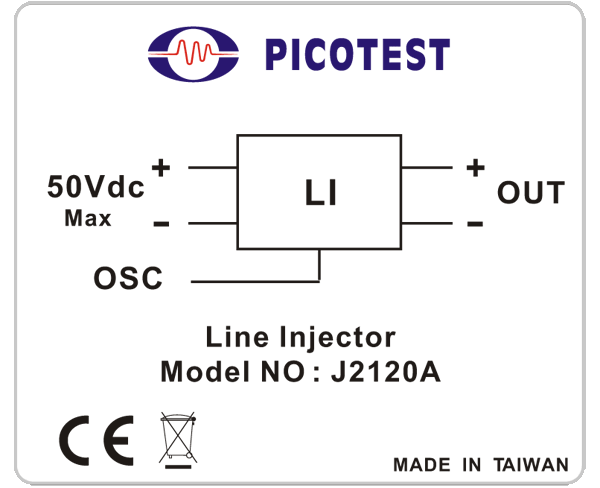PSRR - Line Injector

What's included
J2120A Line Injector
![]() User Manual
User Manual
1 Year Warranty
While the injection transformer is a very wideband adapter, it is not useful for measuring ripple rejection (PSRR) of a power supply or even an opamp. This is because the attributes that make the injection transformer perform so well also result in a transformer that is intolerant of DC current. Even very small DC currents (5mA or less) can greatly reduce the signal capacity or even totally saturate the transformer. For this reason, the Picotest line injector (J2120A) is another essential test adapter.
The line injector allows the input DC supply voltage to be modulated by the network analyzer source signal, as in the case of a PSRR measurement. The line injector must be capable of a frequency range well below the AC line frequency and at least above the control loop bandwidth of the circuit being tested.
The line injector is only capable of sourcing current, so that the output amplitude can be significantly impacted by the operating current and the total storage capacitance at the load. The Bode-100 network analyzer has a very high selectivity so distortion at the output of the line injector generally does not influence the measurement. Again, this is a small signal injector, so the oscillator signals should be kept as small as possible above the noise floor. As a guide, try to keep the input signal amplitude below 50mVpp (-20dBm). In some cases we want to attenuate the source signal even further, and so we have included the attenuators in the injector kits. Some analyzers, such as the Omicron-Lab-Lab Bode-100 allow shaping the injection amplitude as a function of frequency, which helps optimize the signal level.
Measuring Input Impedance
The line injector can also be used in conjunction with a current probe to measure the input impedance of a power supply. The input impedance of a switching power supply or regulator is negative, which is a stability concern when combined with an EMI filter, making the measurement an important part of the design, analysis and verification process. The current probe must be set for 1A/V or the results need to be scaled accordingly for different settings.
Input Impedance – Line Injector/Current Probe

Features
- 10Hz-10MHz usable bandwidth
- Low loss design
- 5 Amps maximum current
- 50VDC max input
- Easily measure input filters and PSRR

Detailed Specifications
| Specifications | |||
| Characteristic | Typical | Units | |
| Maximum DC Input Voltage | 50 | VDC | |
| Maximum Continuous Current | 5 | A | |
| Maximum Voltage Drop | 3.25 | VDC | |
| Modulation Input Impedance | 10K | ohms | |
| 3dB Frequency Response | 15-5M | Hz | |
| Useable Frequency Response | 10-10M | Hz | |
| Recommended Injection Signal | -20 - 0 | dBm | |
| Temperature Range | 0-50 | C | |
| Maximum Altitude | 6000 | Ft | |
| Absolute Maximum Voltage | < 50V (DC + AC) | ||
J2120A Voltage Drop vs Output Current

J2120A Resistance vs Output Current

The J2120A is the lowest impedance injector on the market and can be approximated by the following relationship to operating current.
![]()
Or about 180mOhms at 1Amp
![]() Caution: To avoid equipment damage and/or severe injuries or death ensure that the absolute maximum ratings are observed and not exceeded at all times.
Caution: To avoid equipment damage and/or severe injuries or death ensure that the absolute maximum ratings are observed and not exceeded at all times.
EMI Note: Exceeding 0dBm may cause the unit to exceed CE EMI limits.
